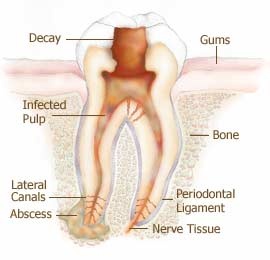 The idea of having Dr. Ballard make use of a dental drill during your next dental check-up is enough to make you cringe. However, given that root canal treatments are capable of keeping your teeth from having to be extracted, you’d be happy to go through the drill for as long as you have your entire set of teeth.
The idea of having Dr. Ballard make use of a dental drill during your next dental check-up is enough to make you cringe. However, given that root canal treatments are capable of keeping your teeth from having to be extracted, you’d be happy to go through the drill for as long as you have your entire set of teeth.
What is root canal treatment?
This treatment is dependent on the three layers of tissues that each tooth is composed of. The innermost layer of the tooth is the pulp, followed by the dentin and the dental enamel layer. When your tooth is diseased, it’s because the pulp has already been involved. When a tooth is extracted, the pulp, together with the rest of the three layers, are removed at the consequence of you losing the tooth. However, it is possible to remove just the pulp but retain the other two layers and the structure of the tooth. This way, your dentist can get rid of the pain but not cause you to lose your tooth.
How do you know that you need to have a root canal treatment?
Dr. Ballard would not advise you to get a root canal treatment at the slightest amount of pain. However, there are a number of telltale signs and symptoms which could make your dentist suggest that you get a root canal treatment. The first and cardinal symptom would have to be pain. Pain does not have to be the extremely excruciating kind for as long as it’s chronic and would interfere with your quality of life. Swelling of surrounding gums would also be evident and this can be due to the bacteria which have already penetrated into the tooth and surrounding tissues. Finally, discoloration of the tooth can be a sign of infection and decay.
What happens during the root canal treatment?
Dr. Ballard would have to make use of the dental drill during root canal procedures because of the fact that this is the only way that the pulp and root canal space can be revealed. Once the hole has been made, Dr. Ballard will then scrape out the pulp so that the nerve tissues and other sensitive tissues can be removed. Once that is done, your dentist will then fill in the now empty root canal space with the help of dental filling material. Afterwards, the tooth is reconstructed. Of course, the entire procedure will render minimal pain because you will be anesthetized and can even be sedated.
Image Courtesy Pinterest




